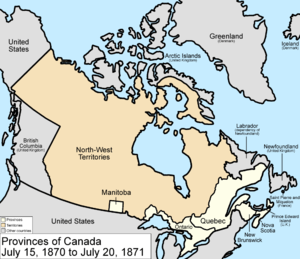Manitoba Act
The Manitoba Act (French: Loi sur le Manitoba),[1] is an act of the Parliament of Canada that is defined by the Constitution Act, 1982[2] as forming a part of the Constitution of Canada. The act, which received the royal assent on May 12, 1870, created the province of Manitoba and continued in force An Act for the Temporary Government of Rupert's Land and the North-Western Territories when united with Canada[3] upon the absorption of the British territories of Rupert's Land and the North-Western Territory into Canada on July 15, 1870.
Background

The act was adopted by Parliament in response to the Métis' concerns of the provisional government led by Louis Riel. Riel was a major influence on the Manitoba Act since it was based on his list of rights. The Red River colony and its surroundings would become the province of Manitoba, which was a tiny area around the Red River Colony. Unlike other provinces, however, Manitoba would have its land and other resources initially controlled by Ottawa. In a victory for the Métis, the act guaranteed that they would receive title for the lands they already farmed and 1,400,000 acres (5,700 km2) of farmland for the use of their children. The act also set aside land for the Métis, with each family receiving scrip, a certificate, saying they owned 96 hectares of land, amount to a total of about 560,000 hectares (5,600 km2). In order to receive scrip for children living or deceased, proof of birth in Manitoba prior to 1871 was required, such as a baptismal or death certificate from the church or a letter from an employer such as the Hudson's Bay Company. The 1.4 million acres was not enough for the number of applications and the government gave money, the equivalent value of $1. per acre which was current land value at that time; for example the head of a household would receive $160. in lieu of a quarter section.
As a result of the settlement, however, Macdonald convinced the British to send a military expedition to Manitoba, led by Colonel Wolseley. White settlers poured into the province, and the Métis were kept waiting for their land grants. Many Métis fled to Saskatchewan, and Louis Riel fled to the United States.
The act contained religious and language rights, namely rights to denominational schools, to laws in both French and English, and to use either English or French in the Legislature of Manitoba and any courts established by either Canada or the Province.[4] This has led to political controversy, however, including the Manitoba Schools Question in the nineteenth century, as denominational school rights were curtailed. The legislature also enacted English-only laws later found unconstitutional by the Supreme Court of Canada in the case Reference re Manitoba Language Rights (1985).
Under the act, Manitoba could send four members to the House of Commons in Ottawa and two members to the Senate.
Validity of the Manitoba Act
Following the enactment of the Manitoba Act, questions arose whether the federal Parliament had the constitutional authority to create new provinces by ordinary federal statute. To eliminate any uncertainty on this point, the Imperial Parliament enacted the Constitution Act, 1871,which confirmed that the federal Parliament had the power to establish new provinces and provide for their constitutions.[5]
See also
References
- ↑ originally entitled An Act to amend and continue the Act 32-33 Victoria, chapter 3; and to establish and provide for the Government of the Province of Manitoba, S.C. 1870, c. 3
- ↑ Constitution Act, 1982, s. 52 and Schedule, Item 2.
- ↑ An Act for the Temporary Government of Rupert's Land and the North-Western Territories when united with Canada, S.C. 1869, c. 3
- ↑ Manitoba Act, 1870, s. 23.
- ↑ Constitution Act, 1871, 34 & 35 Vict. c. 28 (U.K.), s. 2. (Note that the act was originally named the British North America Act, 1871, but was re-named in Canada by the Constitution Act, 1982, s. 53.)
External links
| Wikisource has original text related to this article: |
- L’Encyclopédie de l’histoire du Québec / The Quebec History Encyclopedia: Manitoba Act
- Canadian Encyclopedia: Manitoba Act
- The Solon Law Archive: Manitoba Act 1870